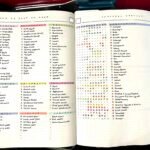Your trusted source for simple, practical nutrition advice and tips for a healthier lifestyle.
A Bullet Journal Meal Plan helps organize meals efficiently and saves time. It ensures balanced, nutritious eating habits.
A Bullet Journal Meal Plan is an innovative way to track and plan meals. It combines creativity with practicality, making meal planning enjoyable. By using a bullet journal, you can easily map out weekly menus, grocery lists, and track dietary goals.
This method reduces food waste and helps save money. It also allows for flexibility, letting you adjust your meals based on your schedule. With visual appeal and functionality, a Bullet Journal Meal Plan can transform your approach to eating, making it healthier and more structured.
Introduction To Bullet Journals
Bullet journals are simple, customizable tools. They help organize your daily life. You can track habits, plan meals, and set goals. They are perfect for anyone who loves to stay organized. Let’s dive into the world of bullet journals and meal planning.
What Is A Bullet Journal?
A bullet journal is a notebook. It combines a planner, diary, and to-do list. You create your own layouts. This makes it very flexible. Some people use dots, others use lines or grids. The key is to make it work for you.
You can use a bullet journal for many things. Some people track their moods. Others write down their exercise routines. Many use it for meal planning. The possibilities are endless.
Benefits Of Using A Bullet Journal
- Organization: Keep all your tasks in one place.
- Customization: Design pages that suit your needs.
- Creativity: Use colors, stickers, and drawings to make it fun.
- Productivity: Track habits and goals to stay motivated.
- Mindfulness: Reflect on your day and plan ahead.
Using a bullet journal can help you eat better. You can plan your meals ahead. This saves time and reduces stress. You can also track what you eat. This helps you stay healthy.
| Day | Breakfast | Lunch | Dinner |
|---|---|---|---|
| Monday | Oatmeal | Salad | Grilled chicken |
| Tuesday | Yogurt | Sandwich | Spaghetti |
| Wednesday | Smoothie | Sushi | Steak |
Start small. Use simple layouts first. Add more details later. A bullet journal is a powerful tool. It can help you achieve your goals. Happy journaling!

Credit: www.youtube.com
Setting Up Your Meal Plan
Creating a meal plan with your bullet journal can be fun and efficient. It helps you stay organized and ensures you have healthy meals throughout the week. Let’s dive into the steps to set up your meal plan.
Choosing The Right Layout
Selecting the right layout is crucial for your meal plan’s success. There are several options to consider:
- Weekly Layout: Ideal for planning meals for each day of the week.
- Monthly Layout: Perfect for those who like to see the entire month at a glance.
- Daily Layout: Great for detailed meal planning, including snacks and drinks.
Choose a layout that fits your lifestyle and planning needs. A weekly layout is popular due to its balance between detail and overview.
Essential Tools And Materials
Having the right tools and materials makes your meal planning easier and more enjoyable.
| Tool/Material | Purpose |
|---|---|
| Bullet Journal | Your main canvas for planning. |
| Pens and Markers | For writing and highlighting different meals. |
| Stickers and Washi Tape | Adds a creative touch to your pages. |
| Ruler | Helps create neat lines and sections. |
| Recipe Cards | Keep your favorite recipes handy. |
Gather these items before you start setting up your meal plan. It ensures a smooth and enjoyable process.
Creating A Weekly Meal Plan
Crafting a weekly meal plan with a bullet journal can save time and reduce stress. It helps organize meals, ensures balanced nutrition, and makes grocery shopping easier. Let’s explore how to create an effective meal plan.
Deciding On Meals
Start by listing your favorite meals. Include breakfast, lunch, and dinner options. Involve your family in the process. This ensures everyone enjoys the meals. Rotate your meals to keep things interesting.
- Breakfast: Pancakes, scrambled eggs, smoothies
- Lunch: Sandwiches, salads, soups
- Dinner: Pasta, stir-fry, grilled chicken
Consider themes for each day. For example, Meatless Mondays or Taco Tuesdays. This simplifies decision-making and adds fun to the routine.
Balancing Nutritional Needs
Ensure each meal has a balance of nutrients. Include proteins, carbs, and healthy fats. Here’s a simple table to guide your planning:
| Meal | Protein | Carbs | Healthy Fats |
|---|---|---|---|
| Breakfast | Eggs | Whole grain toast | Avocado |
| Lunch | Grilled chicken | Quinoa | Olive oil in salad |
| Dinner | Fish | Sweet potatoes | Nuts |
Check dietary needs of all family members. This ensures everyone gets the right nutrients. Adjust portions and ingredients accordingly.
Using a bullet journal for meal planning is effective. It keeps you organized and ensures healthy eating. Plan your meals and enjoy stress-free mealtimes!

Credit: www.reddit.com
Incorporating Grocery Lists
Using a bullet journal for meal planning can make your life easier. Incorporating grocery lists into your bullet journal helps stay organized. It ensures you never forget an item. Below are the ways to incorporate grocery lists into your bullet journal.
Organizing Your List
Start with a simple layout for your grocery list. Use bullet points to list items. Separate items by categories. This makes shopping faster. For example, you can create sections for:
- Fruits and Vegetables
- Dairy Products
- Meat and Fish
- Pantry Staples
Use different colors for each category. This helps in quick identification. You can also add checkboxes next to each item. Tick them off as you shop. This ensures you don’t miss anything.
Planning Shopping Trips
Plan your shopping trips to save time and money. Check your pantry before making a list. Note down what you need. This prevents buying unnecessary items.
Divide your list based on store layout. Group items found in the same aisle. This reduces backtracking. Here is a sample layout:
| Category | Items |
|---|---|
| Fruits and Vegetables | Apples, Bananas, Carrots |
| Dairy Products | Milk, Cheese, Yogurt |
| Meat and Fish | Chicken, Salmon, Beef |
| Pantry Staples | Rice, Pasta, Canned Beans |
Keep your bullet journal with you while shopping. This ensures you have your list handy. You can also add notes about prices or brands. This helps in future shopping trips.
Tracking Dietary Goals
Tracking dietary goals with a bullet journal meal plan can be fun and easy. This method helps you stay organized and focused on your health journey. Below, we explore two important aspects: setting achievable goals and monitoring progress.
Setting Achievable Goals
Start by setting clear and realistic dietary goals. Write these goals in your bullet journal. Here’s how:
- Specific: Define what you want to achieve, like eating more vegetables.
- Measurable: Make sure you can track your progress, like eating 5 servings of vegetables daily.
- Achievable: Ensure your goal is realistic, based on your lifestyle.
- Relevant: Choose goals that matter to your health and wellbeing.
- Time-bound: Set a deadline to reach your goal, like in 30 days.
Monitoring Progress
Use your bullet journal to monitor your dietary progress. Create a table or chart to track your daily intake.
| Day | Fruits | Vegetables | Water (cups) |
|---|---|---|---|
| Monday | 3 | 4 | 8 |
| Tuesday | 2 | 5 | 7 |
| Wednesday | 4 | 3 | 9 |
Check your progress weekly. Adjust your goals if needed. You can also add notes and reflections. This helps you stay motivated and see your improvements.
Remember to celebrate your small victories. This keeps you inspired and committed to your dietary goals.

Credit: littlecoffeefox.com
Adapting To Dietary Restrictions
Adapting your meal plan to fit dietary restrictions can seem challenging. But with a Bullet Journal, it’s easier than you think. This method helps you keep track and stay organized. You can customize your plan and find alternative recipes to fit your needs.
Customizing Your Plan
Start by listing your dietary restrictions. Write them in your Bullet Journal. This helps you see what you need to avoid.
- Allergies: List foods you are allergic to.
- Intolerances: Note any foods that cause discomfort.
- Preferences: Include foods you prefer not to eat.
Next, create a weekly meal plan. Use a table to organize your meals:
Add more days as needed
| Day | Breakfast | Lunch | Dinner |
|---|---|---|---|
| Monday | Oatmeal with berries | Grilled chicken salad | Quinoa with veggies |
| Tuesday | Fruit smoothie | Turkey wrap | Stir-fried tofu |
This table helps you plan meals that fit your restrictions. You can easily see what to prepare each day.
Finding Alternative Recipes
Finding recipes that fit your dietary needs is crucial. Use your Bullet Journal to jot down alternatives.
- Search Online: Use websites that specialize in dietary restrictions.
- Cookbooks: Find books focused on your dietary needs.
- Experiment: Try new ingredients to replace restricted foods.
Here are some examples:
- Gluten-Free: Use almond flour instead of wheat flour.
- Dairy-Free: Replace milk with almond or soy milk.
- Vegan: Use tofu or tempeh as protein sources.
Keep track of your favorite recipes in your Bullet Journal. This helps you quickly find meal ideas that fit your restrictions.
Staying Motivated
Creating a Bullet Journal Meal Plan can be exciting. But staying motivated is key to long-term success. Below are some useful tips and strategies to help you stay on track.
Tips For Consistency
Consistency is crucial for any meal plan. Here are some tips to keep you consistent:
- Set small, achievable goals: Start with easy tasks.
- Track your progress: Use checkboxes and trackers.
- Plan ahead: Dedicate time weekly for planning.
- Use visual aids: Stickers and colors can be motivating.
Overcoming Challenges
Challenges may arise, but they are not insurmountable. Here’s how to overcome them:
| Challenge | Solution |
|---|---|
| Lack of time | Prep meals in batches. |
| Limited ingredients | Use simple, versatile recipes. |
| Loss of interest | Try new recipes regularly. |
Stay motivated by celebrating small wins. Reward yourself for sticking to your plan. Your journey to a healthier you starts with these small steps.
Review And Adjustments
Creating a meal plan is just the first step. Reviewing and adjusting your plan ensures it works best for you. This section explains how to evaluate and tweak your meal plan.
Evaluating Your Plan
Regularly check your bullet journal meal plan. Identify what works and what doesn’t. Ask yourself these questions:
- Did you enjoy the meals?
- Were the recipes easy to follow?
- Did you stay within budget?
- Did you reduce food waste?
Make notes in your journal. Track your answers and look for patterns.
Making Necessary Changes
Based on your evaluation, make changes to your plan. Consider the following:
| Aspect | Possible Change |
|---|---|
| Meal Enjoyment | Replace meals you didn’t enjoy. |
| Recipe Difficulty | Choose simpler recipes. |
| Budget | Opt for cheaper ingredients. |
| Food Waste | Use leftovers creatively. |
Adjusting your plan makes it more effective. Regular tweaks ensure you stay on track.
Frequently Asked Questions
What Is The Bullet Journal Planning Method?
The bullet journal method helps organize tasks, events, and notes using simple bullet points. It boosts productivity and mindfulness.
Is Bullet Journaling Time Consuming?
Bullet journaling can be time consuming, but it depends on your approach. Some people spend hours, while others spend minutes. Customize it to fit your schedule and needs.
How Do You Do A Bullet Journal Every Day?
Start by setting up a daily log. Jot down tasks, events, and notes. Check off completed tasks. Adjust as needed. Keep it simple.
What Is A Bullet Journal Template?
A bullet journal template is a pre-designed layout. It helps organize tasks, events, and goals efficiently. It saves time and boosts productivity.
Conclusion
A bullet journal meal plan streamlines your cooking and shopping. It saves time and reduces stress. This method ensures you eat healthy and stay organized. Try it out and see the benefits for yourself. Start planning your meals today and enjoy a more structured life.





